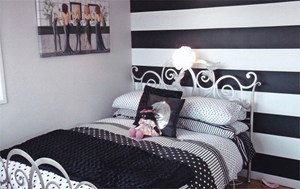
While walls painted in simple, block colours pair well with single-shade carpets or polished wood floors, there is a more daring option available for your home.
Painting stripes on your walls can really bring a room alive, adding personality and a unique colour scheme.
However, this approach doesn't necessarily scream "over the top" – in fact, stripes can add an elegant sophistication to your living room, kitchen or even a child's room.
Go bold or keep it subtle?
One of the most important parts of the interior decorating process is to get your colours right.
When painting stripes on interior walls, this is no exception!
Fiery shades such as Resene California or Resene Daredevil can provide an injection of welcome colour, but they're certainly not options for the faint-hearted when it comes to painting stripes.
If you want to make the most of a smaller room – for instance, a bedroom – opt for more subtle, yet contrasting shades.
Gentle shades such as Resene Secrets or Resene Tasman pair well with neutral whites, such as Resene Alabaster.
You can also combine multiple colours and variations by varying the thickness of the stripes and changing the pattern of the colours.
While the options are endless when it comes to choosing colours, one important consideration is the level of contrast you'd like.
The bolder the colours you select, the bigger the statement you'll make. If you want the stripes to be the focus of attention – rather than the colours per se – stick with more gentle shades or variations of white.
Use Resene Find-A-Colour or a Resene colour chart to help you select the perfect complementary colours.
Sideways or straight up-and-down?
Another important factor to consider before taking these decorating ideas in stride is whether your paint stripes will be vertical or horizontal.
Vertical stripes will elongate a room while horizontal stripes are better in roomier spaces.
If you're opting for a sophisticated bedroom, vertical stripes with block-colour drop curtains could be a good option – provided you've got the space.
Horizontal stripes can look fantastic, but be sure to keep them wide. It's worth having an uneven number of alternating stripes – think five, seven or nine large horizontal stripes running around the interior of a lounge or bedroom.
Once you've chosen your paint colours and the orientation of your stripes, you can embark on the process!
Getting it right
You'll need to measure the height of your wall and divide this by the number of stripes you're after – excluding any skirting boards in the room.
It's essential to have low tack painter's masking tape that you can apply to the wall in order to paint stripes in a straight line.
A low tack masking tape won't remove paint from the wall yet is sticky enough to adhere to the area is important. If the tape doesn't stick down properly, this could cause colours to bleed into each other.
Remember that you're aiming for a fresh, crisp appearance!
The tape will ensure you achieve an even, aligned finish. However, to get the tape itself straight, you'll need a few tools.
A laser measure is a useful asset. While you might not own one of these, you could rent or borrow one in order to get the job done right the first time.
Laser measures can be fixed to a tripod and adjusted depending on where on the wall you want your stripes.
Another option is a regular level and measuring tape. This good old-fashioned approach is still better than nothing. After all, you don't want to invest your time into the process only to end up with a wonky finish!
If you're opting for thick stripes, you can use a paint roller, and touch up the edges with a finer, angled brush. Make sure you remove the tape before it dries completely. This will help prevent lifting paint off the walls.


